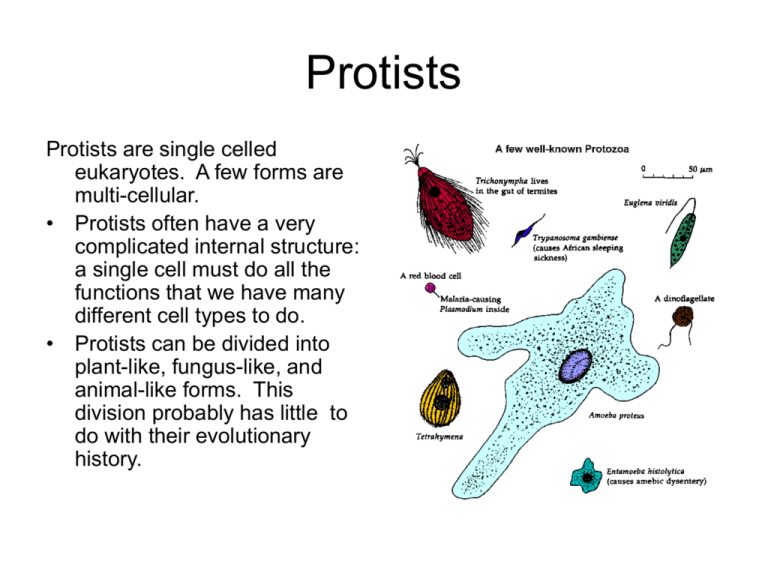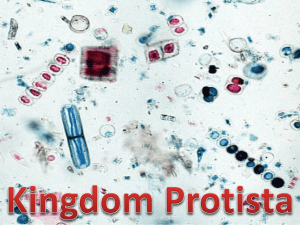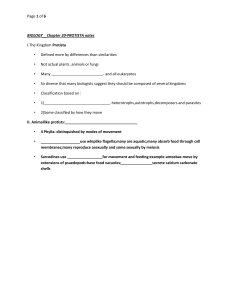Protists
advertisement

Protists Protists are single celled eukaryotes. A few forms are multi-cellular. • Protists often have a very complicated internal structure: a single cell must do all the functions that we have many different cell types to do. • Protists can be divided into plant-like, fungus-like, and animal-like forms. This division probably has little to do with their evolutionary history. Protist Phylogeny • Protists are very diverse, and probably represent several different evolutionary lineages, more distinct from each other than plants, animals, and fungi are. Fungus-like Protists • • • • Water molds and slime molds Like fungi, they are heterotrophs: they get food and energy from other organisms. Many are decomposers of dead organisms. Unlike fungi, the fungus-like protists produce motile (moving) cells during part of their like cycle. Also, these protists surround and engulf bacteria as food. Slime molds live as separate cells most of their lives, feeding on bacteria. When conditions get harsh, they aggregate into a multicellular slug, which migrates to a new location. The slug then forms a fruiting body that generates spores. The spores from the fruiting body are very hardy. Slime Molds • Slime molds can be rather large and colorful. More Fungus-like Protists • The water molds include some of the worst plant diseases. • Phytphthora infestans causes rot in plants. In the 1840’s, Phytophthora caused the potato blight in Ireland. The Irish were poor and overcrowded, and lived mostly on potatoes. The blight caused crop failures in several years, resulting in the deaths of of the population. Many Irish came to the US at that time. Animal-like Protists • The animal-like protists are classified according to how they move: amoeba-like, ciliated, or flagellated. • Amoeba-like protists move by extending pseudopods, part of their cytoplasm, then pulling the rest of the cell along behind. The can surround and engulf their food this way. • Some amoeba-like protists have hard shells. The foraminiferans are covered in calcium carbonate—chalk, which we use on chalk boards. Amoebas in Action Ciliated Protists • Cilia are small hairs surrounding the protist’s body. The cilia beat in a synchronized pattern to cause movement. • Paramecium is a typical ciliate. It has a gullet to swallow food, and a contractile vacuole to get rid of excess water. • Genetics: the DNA used for sexual reproduction is stored in the small micronucleus. A copy of this information is used to run the cell: the copy is kept in the much larger macronucleus. Flagellates • Flagellates have a small number of long flagella, long whiplike hairs that beats to propel the cell. • Some nasty parasites are flagellates, including Giardia lamblia, which causes diarrhea and which is found in most of the surface waters of the US. Another is Trypanosoma brucei, which causes sleeping sickness in Africa. Also Trichmonas vaginalis, a sexually transmitted disease. Sporozoans • • • • Sporozoans are animal-like protists that have part of their life cycle inside the cells of their hosts. The most important example is Plasmodium, the parasite that causes malaria. Malaria kills 1-2 million people each year. Mosquitoes are part of the life cycle. They suck blood from infected humans, ingesting the sporozoans. The sporozoans undergo sexual reproduction in the mosquito’s gut. When the mosquito bites another person, the sporozoans infect the blood and liver of the host. The parasites multiply asexually inside the red blood cells, destroying them as they leave. Algae • The plant-like protists are called algae. Most are single-celled, but a few form large multicellular seaweed. • The plant-like protists have chloroplasts. Some, like the Euglena, also have flagella for movement. • Some, such as the diatoms, have calcium carbonate (chalk) or silica shells. Algae Blooms • Algae blooms are the sudden growth of a large population of single celled algae. They occur near the coastlines, with the algae feed on fertilizer runoff and sewage. Algae blooms deplete the oxygen in the water, killing fish and other organisms. Some of the algae also secrete toxins. Red tide and Pfiesteria are examples of this. Multicellular Algae • • • The multicellular algae are commonly called seaweed. They can be classified into red, brown, and green algae. All have chloroplasts, but the pigments in the chloroplasts vary, giving the different colors. Some, like kelp, are very large and contain several different types of cells and tissues to do specialized work. These include leaves for photosynthesis, gas-filled bladders for buoyancy, the root-like holdfast, and tubes to transport nutrients throughout the body. Algae contain the polysaccharide “agar”, which is tasteless and is used to thicken foods such as soft ice cream. Green Algae • The green algae are the ancestors of plants. The term “plant” implies living on the land or derived from plants living on the land. Green algae and plants have very similar chloroplasts. • Green algae have some unicellular species (such as Chlamydomonas), some simple colonies (such as Volvox), and some relatively complex multicellular organisms (such as Acetabularia). • Green algae are haploid most of their live cycle, with only a very short diploid phase.







